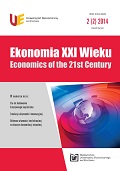Prywatyzacja zasobu mieszkaniowego przejętego przez oddział terenowy agencji nieruchomości rolnych w Olsztynie na przykładzie gmin powiatu olsztyńskie
Privatization of the dwelling stock absorbed by the Olsztyn branch of the agency of agricultural real estate properties –an example of the communes in
Author(s): Mirosława Witkowska-Dąbrowska, Agnieszka Napiórkowska-Baryła, Ilisio Manuel de JesusSubject(s): Economy
Published by: Wydawnictwo Uniwersytetu Ekonomicznego we Wrocławiu
Keywords: flat; privatization of dwelling stock; housing policy
Summary/Abstract: A flat to live is one of the basic amenities, but also the one which is very costly to acquire, and that creates serious obstacles and limitations to purchasing own home. Lacking own place to live, on the other hand, means serious restrictions over the development of any individual or a family. Because of the social and economic functions that residential properties perform, most states do not leave the question of housing to market forces alone, but pursue own housing policy. Housing policy as a research discipline diagnoses differences in the dwelling capacity from the economic, social and technical perspective; it establishes the scale of housing demand and the level to which it is satisfied; finally, it determines the optimal deployment of public funds [Auleytner, Głąbicka 2000]. Housing policy is a targeted action undertaken by national and local state institutions, in which legal and financial instruments are employed to improve the housing situation. The actual legal and financial solutions depend on the approved goals and can be divided into ones shaping the demand or supply on the residential real estate market. Privatization of dwelling stock leading to a higher number of flats with owners is perceived as a housing policy instrument, which can quite easily (in a way that leaves the state budget unaffected) stop and reverse the progressing depreciation of the housing stock. This article presents the results of the privatization effort undertaken to sell the dwelling stock managed by the Olsztyn Branch of the Agency of the Agricultural Real Estate Properties in communes within the District of Olsztyn. The flats within the said stock were sold with rebates to individual owners. At the end of 2011, the number of flats taken over by the Olsztyn Branch of the Agricultural Real Properties and included into the Agricultural Property Stock of the State Treasury was 49647, of which 3999 were in the District of Olsztyn, mainly in the communes of Barczewo, Biskupiec, Purda and Jeziorany. The flats have different origin. Most originate from dissolved state farms (3506 flats) and from the State Land Fund (396 flats). The implemented privatization model, in which flats can be sold with reductions in the prices, has encouraged 94% of the future flat owners to make a preferential purchase. The remaining percentage consists of flats sold by tender bids or transferred free of charge mainly to communes. Owing to the above solution, the privatization of the stock of flats has almost been terminated, although this is true only about the flats from former state farms (flats which remain in the Agricultural Property Stock of the State Treasury account for 0.8% of the original stock) which were sold with reductions in the prices available to both persons renting the flats or former employees of state farms. Regarding the flats from the Land Farm, a narrower group of persons were eligible to apply for rebates, and the Agricultural Property Stock of the State Tr
Journal: Ekonomia XXI Wieku
- Issue Year: 2014
- Issue No: 02
- Page Range: 122-131
- Page Count: 10
- Language: Polish

